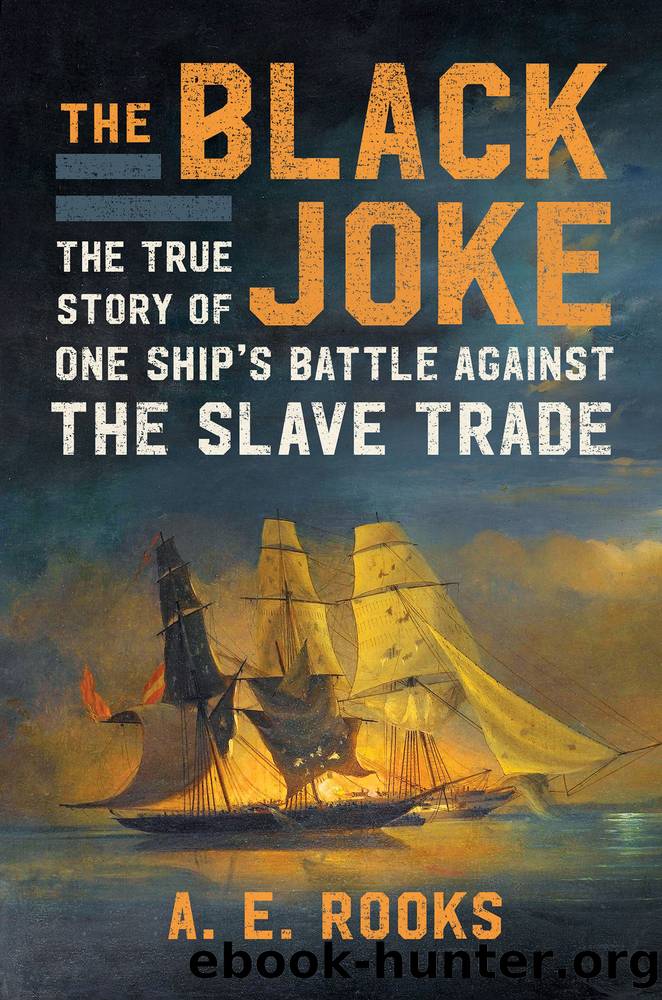The Black Joke: The True Story of One Ship's Battle Against the Slave Trade by A.E. Rooks

Author:A.E. Rooks [Rooks, A.E.]
Language: eng
Format: epub
Published: 2022-01-18T00:00:00+00:00
As Macaulay makes clear, they didnât all stay, but Freetown had been founded as a Black settlement and became an ethnically and culturally diverse Black town in which only roughly 0.85 percent of the stable population was White, and despite the fact that this minuscule percentage of White Europeans held the majority of administrative power, the townâs Blackness apparently irritated Findlay to no end. Nonetheless, his letter questioning the efficacy of the Squadronâs deployment was passed on to the Admiralty.
Rather than looking to the WAS, Findlay might have better spent his time sweeping around his own front door. His racism meant he refused to hire qualified Black people for administrative posts in Freetown and had fired all of the Black people who had previously held those jobs, redistributing them to White European officers who were less qualified, in both experience and education (many of them being young enough to have just left school). And Findlayâs race-baiting histrionics notwithstanding, the intelligence Captain Gordon had received regarding activity around the colony just a few weeks before Findlay sent his nasty note was less âpredation by slavers running amokâ and more âresidents of Sierra Leone using a boat to run guns to French slavers on the Rio Pongas.â Gordon sent the Plumper, back on patrol of the coast, to investigate. Plumper had left boats in the Pongas a couple of weeks prior while searching nearby rivers for quarry, and upon the shipâs return, Plumperâs boat crews had more bad newsâthe slave dealers were rumored to have arranged for four hundred locals to attack the Squadron vessel and its boats and kill everyone. This wasnât an idle threat; eight years earlier, a similar attack had been made against HMS Thistle in the same river, killing two and injuring several more. Anchoring under cover of night, Plumper soon waylaid a schooner attempting to sneak past it and discovered that, sure enough, the ship had sold guns to French slavers farther upriver and was owned by âMr. Smithâ of Freetown. After sending the schooner on for Lieutenant Governor Findlay to deal with, as that was a colonial matter, not a Squadron one, Plumper went even farther inland to investigate. They found a slaver to condemn, but though the assault had never been forthcoming, fever caught on the trip eventually killed twenty-seven members of the crew.
French slave traders had become a much bigger problem that year, and no one in the Squadron, at least, could do much about the reason. France had officially banned the slave trade back in 1818, but since then the government had done little to suppress the French traffic in the enslaved. In effect, all the 1818 measure had done was remove regulations on those traffickers who, much like the then French government, were willing to simply ignore the law, and the trade continued. Administrativelyâespecially given that France had already technically agreed to abolish the tradeâits stance on suppression had shifted by 1826, when French abolitionists discovered and revealed undeniable evidence of Franceâs
Download
This site does not store any files on its server. We only index and link to content provided by other sites. Please contact the content providers to delete copyright contents if any and email us, we'll remove relevant links or contents immediately.
| Automotive | Engineering |
| Transportation |
Machine Learning at Scale with H2O by Gregory Keys | David Whiting(4184)
Never by Ken Follett(3794)
Urban Outlaw by Magnus Walker(3342)
OPNsense Beginner to Professional by Julio Cesar Bueno de Camargo(3251)
Sapiens and Homo Deus by Yuval Noah Harari(2987)
Will by Will Smith(2793)
A Short History of Nearly Everything by Bryson Bill(2629)
Hooked: A Dark, Contemporary Romance (Never After Series) by Emily McIntire(2502)
Rationality by Steven Pinker(2291)
Borders by unknow(2229)
The Becoming by Nora Roberts(2088)
Holy Bible (NIV) by Zondervan(2087)
The One Percenter Encyclopedia by Bill Hayes(1787)
HBR's 10 Must Reads 2022 by Harvard Business Review(1777)
Freedom by Sonny Barger(1772)
A Short History of War by Jeremy Black(1762)
Five Ways to Fall by K.A. Tucker(1701)
Go Tell the Bees That I Am Gone by Diana Gabaldon(1687)
Girls Auto Clinic Glove Box Guide by Patrice Banks(1685)
